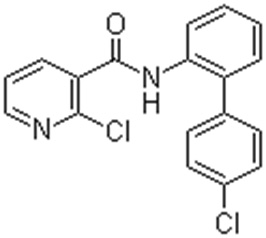| Availability: | |
|---|---|
| Quantity: | |
188425-85-6
97%TC, 25%WDG, 50%WDG, 300SC, 500SC
Boscalid
Common name: Boscalid
CAS No.:188425-85-6

Specification: 97%TC, 25%WDG, 50%WDG, 300SC, 500SC
Molecular formula:C18H12Cl2N2O
Structural formula:


Mode of action:
It can be transferred in plants through leaf osmosis, inhibit mitochondrial succinate dehydrogenase, hinder the tricarboxylic acid cycle, make amino acid and sugar deficiency, reduce energy, interfere with cell division and growth, and have neurological activity to disease, and have protective and therapeutic effects. It can inhibit conidial germination, bacterial tube extension, mycelial growth and spore mother cell to form the main stage of fungal growth and reproduction. The bactericidal action is directly caused by the active substance of the mother, and has no corresponding metabolic activity. It has no cross-resistance to carbendazim and procymidone.
Uses:
Description: A fungicide active against a broad range of fungal pathogens in a wide range of crops including vegetables and other crops.
Example fungi controlled: Botrytis; Powdery mildew; Purple blotch; Rust; Leaf spot; Target spot; Grey mould; Stem rot.
Example applications: Vegetables including beans, brassicas, onions, garlic, shallots, peas, carrots, turnips; Soybeans; Fruits including grapes, apples, pears, strawberries; Tree nuts.
Boscalid
Common name: Boscalid
CAS No.:188425-85-6

Specification: 97%TC, 25%WDG, 50%WDG, 300SC, 500SC
Molecular formula:C18H12Cl2N2O
Structural formula:


Mode of action:
It can be transferred in plants through leaf osmosis, inhibit mitochondrial succinate dehydrogenase, hinder the tricarboxylic acid cycle, make amino acid and sugar deficiency, reduce energy, interfere with cell division and growth, and have neurological activity to disease, and have protective and therapeutic effects. It can inhibit conidial germination, bacterial tube extension, mycelial growth and spore mother cell to form the main stage of fungal growth and reproduction. The bactericidal action is directly caused by the active substance of the mother, and has no corresponding metabolic activity. It has no cross-resistance to carbendazim and procymidone.
Uses:
Description: A fungicide active against a broad range of fungal pathogens in a wide range of crops including vegetables and other crops.
Example fungi controlled: Botrytis; Powdery mildew; Purple blotch; Rust; Leaf spot; Target spot; Grey mould; Stem rot.
Example applications: Vegetables including beans, brassicas, onions, garlic, shallots, peas, carrots, turnips; Soybeans; Fruits including grapes, apples, pears, strawberries; Tree nuts.


